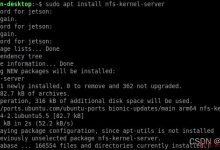cat主要有三大功能:
1.一次显示整个文件。$ cat filename
2.从键盘创建一个文件。$ cat > filename
只能创建新文件,不能编辑已有文件.
3.将几个文件合并为一个文件: $cat file1 file2 > file
参数:
-n 或 –number 由 1 开始对所有输出的行数编号
-b 或 –number-nonblank 和 -n 相似,只不过对于空白行不编号
-s 或 –squeeze-blank 当遇到有连续两行以上的空白行,就代换为一行的空白行
-v 或 –show-nonprinting
例:
把 textfile1 的档案内容加上行号后输入 textfile2 这个档案里
cat -n textfile1 > textfile2
把 textfile1 和 textfile2 的档案内容加上行号(空白行不加)之后将内容附加到 textfile3 里。
cat -b textfile1 textfile2 >> textfile3
把test.txt文件扔进垃圾箱,赋空值test.txt
cat /dev/null > /etc/test.txt
cat 是一个文本文件查看和连接工具。查看一个文件的内容,用cat比较简单,就是cat 后面直接接文件名。
比如:
de>[root@localhost ~]# cat /etc/fstabde>
为了便于新手弟兄灵活掌握这个工具,我们多说一点常用的参数;
1.0 cat 语法结构;
de>cat [选项] [文件]…de>
选项-A, --show-all 等价于 -vET-b, --number-nonblank 对非空输出行编号-e 等价于 -vE-E, --show-ends 在每行结束处显示 $-n, --number 对输出的所有行编号-s, --squeeze-blank 不输出多行空行-t 与 -vT 等价-T, --show-tabs 将跳 字符显示为 ^I-u (被忽略)-v, --show-nonprinting 使用 ^ 和 M- 引用,除了 LFD 和 TAB 之外--help 显示此帮助信息并离开
1.1 cat 查看文件内容实例;
de>[root@localhost ~]# cat /etc/profile 注:查看/etc/目录下的profile文件内容;
[root@localhost ~]# cat -b /etc/fstab 注:查看/etc/目录下的profile内容,并且对非空白行进行编号,行号从1开始;
[root@localhost ~]# cat -n /etc/profile 注:对/etc目录中的profile的所有的行(包括空白行)进行编号输出显示;
[root@localhost ~]# cat -E /etc/profile 注:查看/etc/下的profile内容,并且在每行的结尾处附加$符号;de>
cat 加参数-n 和nl工具差不多,文件内容输出的同时,都会在每行前面加上行号;
de>[root@localhost ~]# cat -n /etc/profile
[root@localhost ~]# nl /etc/profilede>
cat 可以同时显示多个文件的内容,比如我们可以在一个cat命令上同时显示两个文件的内容;
de>[root@localhost ~]# cat /etc/fstab /etc/profilede>
cat 对于内容极大的文件来说,可以通过管道|传送到more 工具,然后一页一页的查看;
de>[root@localhost ~]# cat /etc/fstab /etc/profile | morede>
1.2 cat 的创建、连接文件功能实例;
cat 有创建文件的功能,创建文件后,要以EOF或STOP结束;
de>[root@localhost ~]# cat > linuxsir.org.txt << EOF 注:创建linuxsir.org.txt文件;
> 我来测试 cat 创建文件,并且为文件输入内容; 注:这是为linuxsir.org.txt文件输入内容;
> 北南南北 测试; 注:这是为linuxsir.org.txt文件输入内容;
> EOF 注:退出编辑状态;
[root@localhost ~]# cat linuxsir.org.txt 注:我们查看一下linuxsir.org.txt文件的内容;
我来测试 cat 创建文件,并且为文件输入内容;
北南南北 测试;de>
cat 还有向已存在的文件追加内容的功能;
de>[root@localhost ~]# cat linuxsir.txt 注:查看已存在的文件linuxsir.txt 内容;
I am BeiNanNanBei From LinuxSir.Org . 注:内容行
我正在为cat命令写文档
[root@localhost ~]# cat >> linuxsir.txt << EOF 注:我们向linuxsir.txt文件追加内容;
> 我来测试cat向文档追加内容的功能; 注:这是追回的内容
> OK?
> OK~
> 北南 呈上
> EOF 注:以EOF退出;
[root@localhost ~]# cat linuxsir.txt 注:查看文件内容,看是否追回成功。
I am BeiNanNanBei From LinuxSir.Org .
我正在为cat命令写文档
我来测试cat向文档追加内容的功能;
OK?
OK~
北南 呈上de>
cat 连接多个文件的内容并且输出到一个新文件中;
假设我们有sir01.txt、sir02.tx和sir03.txt ,并且内容如下;
de>[root@localhost ~]# cat sir01.txt
123456
i am testing
[root@localhost ~]# cat sir02.txt
56789
BeiNan Tested
[root@localhost ~]# cat sir03.txt
09876
linuxsir.org testingde>
我想通过cat 把sir01.txt、sir02.txt及sir03.txt 三个文件连接在一起(也就是说把这三个文件的内容都接在一起)并输出到一个新的文件sir04.txt 中。
注意:其原理是把三个文件的内容连接起来,然后创建sir04.txt文件,并且把几个文件的内容同时写入sir04.txt中。特别值得一提的是,如果您输入到一个已经存在的sir04.txt 文件,会把sir04.txt内容清空。
de>[root@localhost ~]# cat sir01.txt sir02.txt sir03.txt > sir04.txt
[root@localhost ~]# more sir04.txt
123456
i am testing
56789
BeiNan Tested
09876
linuxsir.org testingde>
cat 把一个或多个已存在的文件内容,追加到一个已存在的文件中
de>[root@localhost ~]# cat sir00.txt
linuxsir.org forever
[root@localhost ~]# cat sir01.txt sir02.txt sir03.txt >> sir00.txt
[root@localhost ~]# cat sir00.txt
linuxsir.org forever
123456
i am testing
56789
BeiNan Tested
09876
linuxsir.org testingde>
 爱站程序员基地
爱站程序员基地


